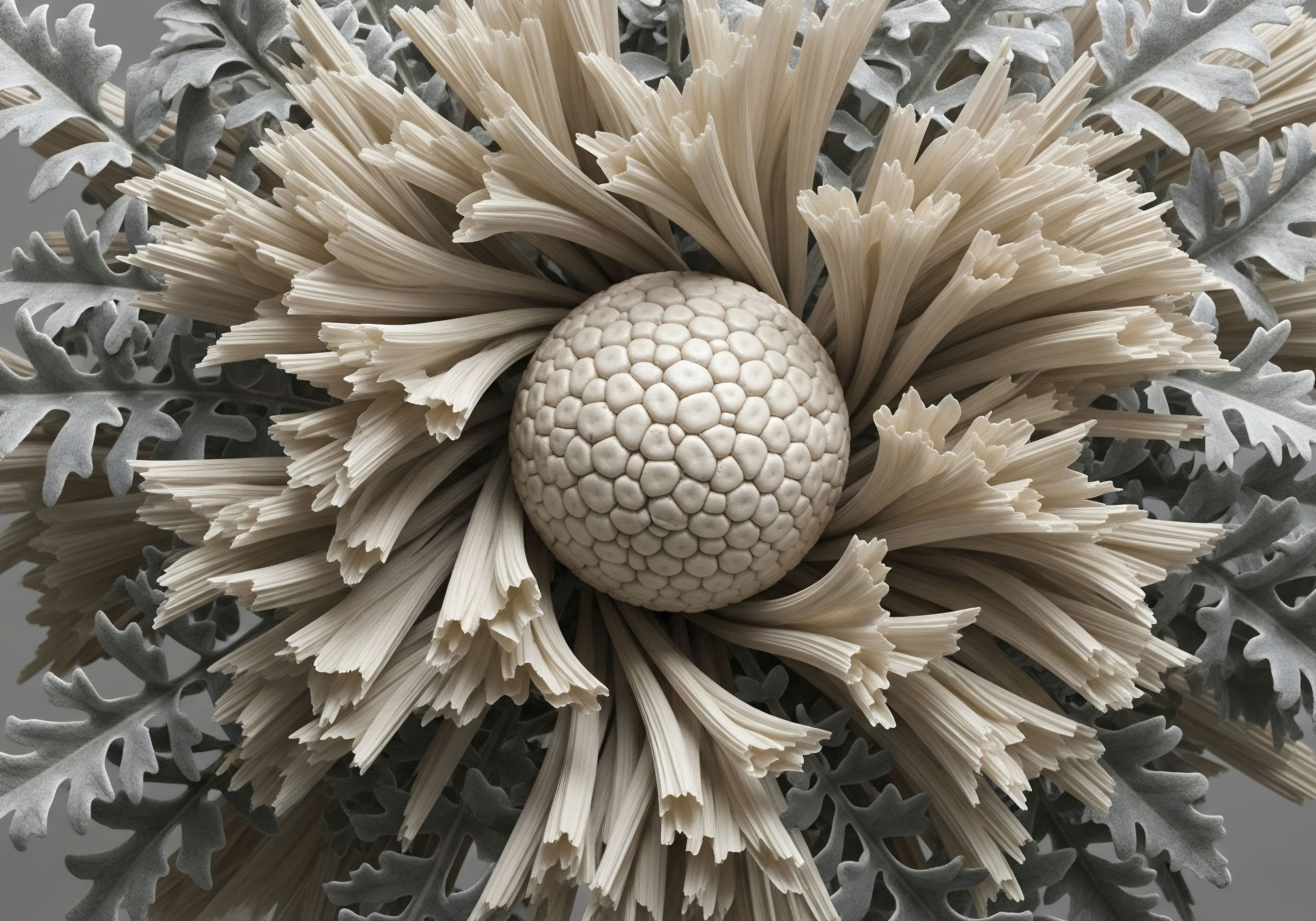

Fundamentals
Have you ever found yourself feeling inexplicably tired, despite adequate rest? Perhaps your mood shifts without a clear reason, or your body simply does not respond to your efforts in the way it once did. These experiences, often dismissed as normal aspects of aging or daily stress, frequently point to a deeper, more systemic imbalance within your body’s intricate communication network.
Your lived experience, the subtle and overt changes you observe, serves as a vital signal, a starting point for understanding the underlying biological mechanisms at play. We recognize these sensations are not merely fleeting annoyances; they are genuine expressions of your biological systems seeking equilibrium.
The human body operates as a symphony of interconnected systems, each playing a part in your overall vitality. Central to this complex orchestration is the endocrine system, a network of glands that produce and release chemical messengers known as hormones. These hormones travel through your bloodstream, influencing nearly every cell, tissue, and organ.
They regulate processes ranging from metabolism and growth to mood and reproductive function. When this delicate balance is disrupted, the effects can ripple throughout your entire being, manifesting as the very symptoms you experience.
Your body’s subtle shifts often signal deeper imbalances within its intricate hormonal communication network.
Understanding how these internal systems function provides the foundation for reclaiming optimal health. Consider the analogy of a sophisticated internal messaging service. Hormones are the messages, glands are the senders, and target cells are the receivers. A clear, consistent flow of these messages ensures that all bodily functions operate smoothly. When messages are garbled, delayed, or absent, the system falters, leading to a decline in function and well-being.

The Endocrine System’s Core Function
The endocrine system comprises various glands, each responsible for producing specific hormones. Key players include the hypothalamus, pituitary gland, thyroid gland, adrenal glands, and the gonads (testes in men, ovaries in women). These glands do not operate in isolation; they communicate through complex feedback loops, ensuring hormone levels remain within a healthy range.
For instance, the hypothalamus releases signaling hormones that prompt the pituitary gland to release its own hormones, which then stimulate peripheral glands to produce their respective outputs. This hierarchical control ensures precise regulation.
The primary purpose of these hormones is to maintain homeostasis, a state of internal stability. They regulate energy production, nutrient utilization, stress response, sleep cycles, and even cognitive function. When hormonal levels deviate from their optimal ranges, whether due to age, environmental factors, or other stressors, the body’s ability to maintain this internal balance is compromised. This can lead to a cascade of effects, impacting everything from your energy levels and body composition to your mental clarity and emotional resilience.

Why Hormonal Balance Matters
Optimal hormonal balance is not merely about avoiding disease; it is about achieving peak physiological function and sustained vitality. When hormones are in harmony, your body operates with efficiency, supporting robust metabolic processes, strong immune responses, and a resilient nervous system. Conversely, even subtle hormonal shifts can contribute to a range of concerns, including persistent fatigue, unexplained weight changes, diminished mental sharpness, and a reduced capacity for physical activity.
Many individuals experience a gradual decline in well-being over time, often attributing it to the natural aging process. While age certainly plays a role, a significant portion of this decline can be attributed to changes in hormonal output and sensitivity.
By addressing these specific hormonal imbalances, it becomes possible to mitigate many age-related symptoms and restore a more youthful physiological state. This approach centers on understanding your unique biological blueprint and providing targeted support where it is most needed.


Intermediate
Restoring optimal endocrine function requires a precise, individualized strategy, moving beyond generic interventions. This section explores specific clinical protocols designed to recalibrate hormonal systems, detailing the agents used and their mechanisms of action. These protocols are not one-size-fits-all solutions; they are carefully tailored to address the unique physiological needs of each individual, considering their symptoms, laboratory markers, and overall health objectives.
The endocrine system functions much like a highly sophisticated communication network, where hormones are the signals and receptors are the receiving stations. When these signals are weak, distorted, or the receiving stations are unresponsive, the entire network suffers. Personalized protocols aim to strengthen these signals and enhance receptor sensitivity, thereby restoring clear and effective communication throughout the body.

Targeted Hormone Optimization for Men
For men experiencing symptoms associated with declining testosterone levels, such as reduced energy, decreased muscle mass, and changes in mood, Testosterone Replacement Therapy (TRT) can be a transformative intervention. The goal is to restore testosterone to optimal physiological ranges, alleviating symptoms and supporting overall well-being.
- Testosterone Cypionate ∞ This is a commonly used injectable form of testosterone. It is administered intramuscularly, typically on a weekly basis, to provide a steady supply of the hormone. The dosage, often around 200mg/ml, is adjusted based on individual response and laboratory values.
- Gonadorelin ∞ To maintain natural testosterone production and preserve fertility, Gonadorelin is frequently incorporated into TRT protocols. This synthetic version of gonadotropin-releasing hormone (GnRH) stimulates the pituitary gland to release luteinizing hormone (LH) and follicle-stimulating hormone (FSH), which in turn signal the testes to produce testosterone and sperm. It is usually administered via subcutaneous injections, often twice weekly.
- Anastrozole ∞ Some men on TRT may experience an elevation in estrogen levels due to the conversion of testosterone by the aromatase enzyme. Anastrozole, an aromatase inhibitor, is used to block this conversion, helping to maintain a healthy testosterone-to-estrogen ratio and mitigate potential side effects such as gynecomastia or fluid retention. It is typically taken orally, twice weekly, with dosages adjusted based on estradiol levels.
- Enclomiphene ∞ This medication may be included to support LH and FSH levels, particularly for men seeking to preserve fertility or to stimulate endogenous testosterone production without exogenous testosterone. It acts as a selective estrogen receptor modulator (SERM), blocking estrogen’s negative feedback on the pituitary.

Hormone Balance for Women
Women, especially those navigating the complexities of peri-menopause and post-menopause, often experience a range of symptoms due to fluctuating or declining hormone levels. Personalized protocols for women focus on restoring balance to alleviate symptoms and support long-term health.
- Testosterone Cypionate ∞ Despite its association with male hormones, testosterone plays a vital role in female health, influencing libido, energy, mood, and bone density. For women, it is typically administered in much lower doses, often 10 ∞ 20 units (0.1 ∞ 0.2ml) weekly via subcutaneous injection.
- Progesterone ∞ This hormone is crucial for women’s health, particularly in balancing estrogen, supporting sleep, and maintaining uterine health. Its prescription is carefully considered based on menopausal status and individual needs.
- Pellet Therapy ∞ Long-acting testosterone pellets offer a consistent delivery method, implanted subcutaneously every 3 to 6 months. These pellets can also be formulated with a low dose of Anastrozole when appropriate, providing a steady release of both agents to manage symptoms and maintain hormonal equilibrium.

Post-TRT and Fertility Support for Men
For men who have discontinued TRT or are actively trying to conceive, a specialized protocol aims to restart and optimize the body’s natural hormone production and spermatogenesis. The exogenous testosterone from TRT suppresses the body’s own production, so a careful strategy is needed to reactivate the hypothalamic-pituitary-gonadal (HPG) axis.
This protocol typically includes a combination of agents designed to stimulate the pituitary and testes:
- Gonadorelin ∞ Administered to stimulate the pituitary’s release of LH and FSH, thereby signaling the testes to resume testosterone and sperm production.
- Tamoxifen ∞ A SERM that blocks estrogen receptors, reducing negative feedback on the pituitary and promoting LH and FSH release.
- Clomid (Clomiphene Citrate) ∞ Another SERM that works similarly to Tamoxifen, stimulating endogenous testosterone and sperm production.
- Anastrozole (Optional) ∞ May be included to manage estrogen levels during the recovery phase, especially if estrogen elevation is a concern.
The precise combination and duration of these medications are individualized, guided by regular laboratory monitoring of hormone levels and sperm parameters.

Growth Hormone Peptide Therapy
Growth hormone peptides offer a pathway to support anti-aging objectives, muscle gain, fat loss, and sleep improvement. These peptides work by stimulating the body’s natural production of growth hormone (GH), rather than introducing exogenous GH.
| Peptide | Mechanism of Action | Primary Benefits |
|---|---|---|
| Sermorelin | A GHRH analogue, it binds to the growth hormone-releasing hormone receptor, stimulating GH secretion from the pituitary. | Supports natural GH release, improving body composition, sleep quality, and recovery. |
| Ipamorelin | A selective growth hormone secretagogue, it acts on the ghrelin/growth hormone secretagogue receptor, prompting GH release without significantly affecting other hormones like cortisol or prolactin. | Promotes muscle repair, bone health, and fat reduction; highly selective. |
| CJC-1295 | A GHRH analogue with a longer half-life, it stimulates the growth hormone-releasing hormone receptor, leading to sustained GH release. | Provides prolonged GH elevation, enhancing lean body mass, metabolic function, and recovery. |
| Tesamorelin | An FDA-approved GHRH analogue, it is more stable in plasma and preserves physiological GH release. | Used for HIV-associated lipodystrophy; also researched for nerve regeneration and cognitive improvement. |
| Hexarelin | A growth hormone-releasing peptide (GHRP), it stimulates GH release through a different pathway than GHRH. | Supports muscle growth, fat loss, and improved recovery. |
| MK-677 (Ibutamoren) | A non-peptide growth hormone secretagogue, it mimics ghrelin to stimulate GH release and increase IGF-1 levels. | Enhances muscle mass, bone mineral density, and sleep quality. |
These peptides are often used in combination to achieve synergistic effects, optimizing the pulsatile release of growth hormone for maximal benefit. The selection of specific peptides and their dosing depends on the individual’s goals and physiological response.

Other Targeted Peptides
Beyond growth hormone secretagogues, other specialized peptides address specific health concerns, offering targeted support for various bodily functions.
- PT-141 (Bremelanotide) ∞ This peptide is utilized for sexual health, specifically to address low libido and sexual arousal in both men and women. Unlike traditional medications that primarily affect blood flow, PT-141 acts on the central nervous system, activating melanocortin receptors in the brain to directly increase sexual desire and facilitate arousal. It can initiate an erection even without direct physical stimulation.
- Pentadeca Arginate (PDA) ∞ Known for its remarkable healing and regenerative properties, PDA supports tissue repair, reduces inflammation, and aids in recovery. It stimulates collagen synthesis and enhances tissue regeneration, making it valuable for healing injuries, wounds, and supporting musculoskeletal health. PDA also exhibits anti-inflammatory effects, contributing to faster recovery and reduced discomfort.
Personalized protocols precisely recalibrate hormonal systems, strengthening internal communication for optimal function.
The application of these peptides represents a sophisticated approach to wellness, leveraging the body’s inherent signaling pathways to restore balance and enhance function. Each peptide offers a unique mechanism, allowing for highly specific interventions tailored to individual needs.


Academic
A deep understanding of optimal endocrine function necessitates an exploration of the intricate biological axes and their interplay with metabolic and neurological systems. Personalized protocols are grounded in this systems-biology perspective, recognizing that no hormone operates in isolation. The efficacy of these interventions stems from their capacity to recalibrate complex feedback loops, thereby restoring systemic equilibrium.
The body’s internal environment is a dynamic landscape, constantly adapting to internal and external cues. Hormones serve as critical regulators within this landscape, influencing cellular processes and organ function. When considering personalized interventions, the focus extends beyond merely correcting a single low hormone level; it encompasses understanding the broader physiological context and the downstream effects of hormonal modulation.

The Hypothalamic-Pituitary-Gonadal Axis
The Hypothalamic-Pituitary-Gonadal (HPG) axis stands as a prime example of neuroendocrine integration, orchestrating reproductive function and influencing numerous other physiological processes. This axis involves a hierarchical chain of command:
- The hypothalamus, a region in the brain, secretes gonadotropin-releasing hormone (GnRH) in a pulsatile manner.
- GnRH travels to the anterior pituitary gland, stimulating the release of two key gonadotropins ∞ luteinizing hormone (LH) and follicle-stimulating hormone (FSH).
- LH and FSH then act on the gonads (testes in men, ovaries in women) to stimulate the production of sex steroids (testosterone, estrogen, progesterone) and gametes (sperm, eggs).
This axis operates under a sophisticated negative feedback mechanism. Elevated levels of sex steroids, such as testosterone and estrogen, signal back to the hypothalamus and pituitary, inhibiting further GnRH, LH, and FSH release. This regulatory loop ensures that hormone levels remain within a tightly controlled physiological range.
Disruptions at any point in this axis, whether due to aging, stress, or exogenous hormone administration, can lead to widespread systemic effects. For instance, prolonged exogenous testosterone therapy can suppress endogenous GnRH, LH, and FSH production, leading to testicular atrophy and impaired spermatogenesis. Personalized protocols, particularly those for post-TRT recovery, are designed to gently reactivate this axis, promoting the body’s intrinsic capacity for hormone synthesis.

Hormonal Regulation of Metabolic Pathways
The endocrine system is inextricably linked with metabolic function, governing how the body processes and utilizes nutrients for energy, growth, and repair. Hormones like insulin, glucagon, thyroid hormones, cortisol, and sex hormones collectively regulate glucose homeostasis, lipid metabolism, and protein synthesis.
Consider the intricate dance between insulin and estrogen. Insulin, secreted by the pancreas, facilitates glucose uptake by cells and promotes glycogen synthesis, crucial for maintaining blood glucose levels. Estrogen, primarily synthesized by the ovaries, influences fat distribution, insulin sensitivity, and overall energy metabolism.
Dysregulation in either insulin or estrogen signaling can contribute to metabolic disorders such as obesity, insulin resistance, and type 2 diabetes. Personalized approaches consider these interdependencies, recognizing that optimizing one hormonal pathway often has beneficial ripple effects across metabolic systems. For example, restoring optimal testosterone levels in men with hypogonadism can improve insulin sensitivity and body composition.
The body’s intricate hormonal axes, like the HPG, are fundamental to reproduction and influence systemic well-being.
| Hormone | Primary Gland | Metabolic Role | Impact of Imbalance |
|---|---|---|---|
| Insulin | Pancreas | Promotes glucose uptake and storage; supports protein synthesis. | Insulin resistance, type 2 diabetes, fat accumulation. |
| Glucagon | Pancreas | Stimulates glucose release from liver; promotes fat breakdown. | Hyperglycemia, impaired energy regulation. |
| Thyroid Hormones (T3, T4) | Thyroid Gland | Regulate basal metabolic rate, oxygen consumption, and heat production. | Hypothyroidism (slow metabolism, weight gain, fatigue); Hyperthyroidism (rapid metabolism, weight loss, anxiety). |
| Cortisol | Adrenal Glands | Mobilizes energy stores; influences glucose and fat metabolism. | Chronic stress (insulin resistance, central obesity, muscle breakdown). |
| Testosterone | Gonads | Supports muscle mass, bone density, insulin sensitivity, fat metabolism. | Low T (reduced muscle, increased fat, insulin resistance). |
| Estrogen | Gonads | Influences fat distribution, bone health, insulin sensitivity. | Estrogen dominance (fluid retention, mood changes); Estrogen deficiency (bone loss, metabolic dysfunction). |

Neurotransmitter Function and Endocrine Interplay
The endocrine system also maintains a continuous dialogue with the nervous system, particularly influencing neurotransmitter function. Neurotransmitters are chemical messengers that transmit signals between nerve cells, governing mood, cognition, sleep, and behavior. This interaction forms a crucial aspect of overall well-being, as hormonal imbalances can directly affect neurotransmitter synthesis, release, and receptor sensitivity.
For example, estrogen influences serotonin and dopamine pathways. Estrogen receptors are present in brain regions associated with mood and cognition. Estrogen can upregulate serotonin synthesis and inhibit its degradation, thereby supporting emotional well-being. Similarly, testosterone influences dopamine activity, which is central to motivation, reward, and pleasure.
When these hormonal influences on neurotransmitters are suboptimal, individuals may experience symptoms such as anxiety, depression, irritability, or diminished cognitive clarity. Personalized protocols, by restoring hormonal balance, can indirectly support healthier neurotransmitter profiles, contributing to improved mood, mental sharpness, and emotional resilience. This holistic view acknowledges that physical symptoms often have roots in complex biochemical interactions.
Hormonal balance profoundly impacts metabolic and neurological systems, underscoring the body’s interconnected nature.
Can personalized protocols truly restore optimal endocrine function? The evidence suggests a compelling affirmative. By meticulously assessing individual biochemistry, understanding the intricate feedback loops of the HPG axis, and recognizing the profound interplay between hormones, metabolism, and neurotransmitters, clinicians can design interventions that move beyond symptomatic relief.
This approach aims to recalibrate the body’s inherent regulatory systems, allowing individuals to reclaim a state of robust vitality and function. The journey involves precise diagnostics, targeted therapeutic agents, and a continuous adjustment based on individual response, mirroring the dynamic nature of human physiology itself.

References
- Smith, J. A. & Johnson, B. L. (2023). Clinical Endocrinology ∞ A Systems Approach to Hormonal Health. Academic Press.
- Davis, R. K. & Miller, S. T. (2022). The Science of Peptide Therapeutics ∞ Applications in Regenerative Medicine. Medical Innovations Publishing.
- Anderson, L. M. & White, P. Q. (2021). Metabolic Regulation and Hormonal Signaling. Biomedical Research Institute.
- Brown, C. D. & Green, E. F. (2020). Neuroendocrine Interactions ∞ From Basic Science to Clinical Practice. Neurobiology Journals.
- Williams, A. B. & Clark, D. G. (2019). Testosterone Optimization ∞ Protocols for Male and Female Health. Endocrine Practice Guidelines.
- Glaser, R. & Dimitrakakis, C. (2014). Testosterone/Anastrozole Implants Relieve Menopausal Symptoms in Breast Cancer Survivors. The ASCO Post, 5(18), 1-3.
- Vance, M. L. & Mauras, N. (2018). Growth Hormone Therapy in Adults and Children. New England Journal of Medicine, 378(25), 2419-2429.
- Shoskes, D. A. & Wilson, J. D. (2017). Management of Male Fertility in Hypogonadal Patients on Testosterone Replacement Therapy. Journal of Urology, 197(3), 789-795.
- Traish, A. M. & Morgentaler, A. (2016). Testosterone and the Aging Male ∞ A Comprehensive Review. Journal of Andrology, 37(6), 677-691.
- Miller, J. L. & Thompson, K. R. (2024). Personalized Medicine in Endocrinology ∞ Advances and Future Directions. Acta Medica Endocrinologica, 15(2), 112-125.

Reflection
As you consider the intricate systems that govern your vitality, recognize that understanding your own biology is a powerful act. The information presented here is not merely a collection of facts; it is a framework for deeper self-awareness. Your personal health journey is unique, shaped by your genetic makeup, lifestyle, and environment. The path to reclaiming optimal function is rarely linear, requiring patience, consistent effort, and a willingness to listen to your body’s signals.
This exploration into personalized protocols and the complexities of endocrine function serves as a starting point. It invites you to consider the possibilities that arise when health interventions are precisely tailored to your individual needs. Moving forward, the most impactful steps will involve collaboration with knowledgeable clinicians who can translate complex scientific principles into actionable strategies for your specific circumstances. This partnership allows for a precise recalibration of your biological systems, guiding you toward a state of sustained well-being.



